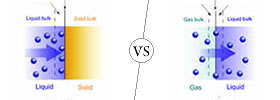Difference between Asteroids and Planets
Key difference between astroids and planets: The International Astronomical Union (IAU) defines a planet as “a celestial body that: (a) is in orbit around the Sun, (b) has sufficient mass for its self-gravity to overcome rigid body forces so that it assumes a hydrostatic equilibrium (nearly round) shape, and (c) has cleared the neighborhood around its orbit.” An asteroid is a large chunk of rock that orbits around the sun. Hence, asteroids are effectively part of our Solar system. Asteroids are also known as planetoids or minor planets. The term minor planet is actually preferred in scientific communities.
include("ad4th.php"); ?>
 A planet is a large object that orbits around a star or a stellar remnant. This is mainly due to its own gravity and gravity of the star that allows the planet to have an orbit around the star. The orbit is usually elliptical in shape, mainly depending on the gravitational force of the planet and the star.
A planet is a large object that orbits around a star or a stellar remnant. This is mainly due to its own gravity and gravity of the star that allows the planet to have an orbit around the star. The orbit is usually elliptical in shape, mainly depending on the gravitational force of the planet and the star.
Also see: Difference between dwarf planet and asteroids
The gravitational force of the planet is strong enough that it leads the planet to be rounded, i.e. compound its matter in a spherical shape. A planet has also cleared its neighboring region of any other debris. The planetesimals, i.e. other debris, should either get absorbed into the planet, or if it big enough to have a gravitational force of its own, it might become a satellite of the planet, i.e. moon, or will just float away into space.
As per the International Astronomical Union (IAU), “A "planet" is a celestial body that: (a) is in orbit around the Sun, (b) has sufficient mass for its self-gravity to overcome rigid body forces so that it assumes a hydrostatic equilibrium (nearly round) shape, and (c) has cleared the neighbourhood around its orbit.”
include("ad3rd.php"); ?>
Hence, as per this definition, there are currently eight planets in our solar system: Mercury, Venus, Earth, Mars, Jupiter, Saturn, Uranus, and Neptune, in order of distance from the Sun.
 An asteroid, on the other hand, is a large chunk of rock that orbits around the sun. Hence, asteroids are effectively part of our Solar system. Asteroids are also known as planetoids or minor planets. The term minor planet is actually preferred in scientific communities.
An asteroid, on the other hand, is a large chunk of rock that orbits around the sun. Hence, asteroids are effectively part of our Solar system. Asteroids are also known as planetoids or minor planets. The term minor planet is actually preferred in scientific communities.
Also see: Difference between planets and plutoids
There are effectively millions of asteroids. Most asteroids in our solar system are part of the asteroid belt located between the orbits of Mars and Jupiter. The asteroid belt consists of tens of thousands of asteroids. They are generally rocks that have a high metallic content but no atmosphere. The size of an asteroid can range anywhere between a few meters wide and hundreds of km wide. They are smaller than planets but like planets, some even have their own moons.
According to IAU’s definition, asteroids cannot be classified as planets. While, asteroids, like planets orbit around the Sun, they are too small and hence lack the gravitational pull to compound itself in a spherical shape. They are also not strong enough to have cleared their vicinity of other objects, such as other asteroids, meteoroids, etc. This is mainly why most of the asteroids in our Solar System are part of the asteroid belt between Mars and Jupiter.
Image Courtesy: nineplanets.org, todayifoundout.com









Add new comment